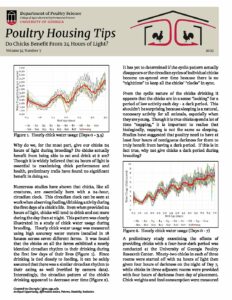Why do we, for the most part, give our chicks 24 hours of light during brooding? Do chicks actually benefit from being able to eat and drink at 2 am? Though it is widely believed that 24 hours of light is essential to maximizing chick performance and health, preliminary trails have found no significant benefit in doing so.
Numerous studies have shown that chicks, like all creatures, are essentially born with a 24-hour, circadian clock. This circadian clock can be seen at work when o...bserving feeding/drinking activity during the first days of a chick’s life. Even when provided 24 hours of light, chicks will tend to drink and eat more during the day than at night. This pattern was clearly illustrated in a study of chick water usage during brooding. Hourly chick water usage was measured using high accuracy water meters installed in 18 houses across seven different farms. It was found that the chicks on all the farms exhibited a nearly identical circadian rhythm to their drinking during the first few days of their lives (Figure 1). Since drinking is tied closely to feeding, it can be safely assumed that there was a similar circadian rhythm to their eating as well (verified by camera data). Interestingly, the circadian pattern of the chick’s drinking appeared to decrease over time (Figure 2). It has yet to determined if the cyclic pattern actually disappears or the circadian cycles of individual chicks become un-synced over time because there is no “nighttime” to keep all the chicks’ “clocks” in sync.
From the cyclic nature of the chicks drinking it appears that the chicks are in a sense “looking” for a period of low activity each day - a dark period. This shouldn’t be surprising because sleeping is a natural, necessary activity for all animals, especially when they are young. Though it is true chicks spend a lot of time “napping,” it is important to realize that biologically, napping is not the same as sleeping. Studies have suggested that poultry need to have at least four hours of contiguous darkness for them to truly benefit from having a dark period. If this is in fact true, why not give chicks a dark period during brooding?
A preliminary study examining the effects of providing chicks with a four-hour-dark period was conducted at the University of Georgia Poultry Research Center. Ninety-two chicks in each of three rooms were started off with 24 hours of light then given four hours of darkness on the night of Day 7, while chicks in three adjacent rooms were provided with four hours of darkness from day of placement. Chick weights and feed consumption were measured on Days 0, 3, 7, 10 and 14. Mortality was monitored and recorded on a daily basis. The study was repeated three times.
Age Variable Treatment
24 Hours 20 Hours
0 Weight 43 g 43 g
3 Weight 85 g 82 g
Feed conversion 0.70 0.72
7 Weight 188 g 182 g
Feed conversion 0.84 0.84
10 Weight 299 g 306 g
Feed conversion 0.99 0.98
14 Weight 528 g 537 g
Feed conversion 1.08 1.09
Table 1. Chick performance
Table 1 summarizes chick performance for the three trials. The bolded values indicate a significant difference between treatments for the variable listed. If neither value is bolded then it indicates that the values are essentially the same. Chicks given 24 hours of light were found to have slightly higher weights on Days 3 and 7 than those with a dark period. Three days after the control birds were given four hours darkness, it was found that the treatment chicks tended to weigh significantly more than the control chicks. By Day 14 there was no significant difference in weight between the treatment and control birds. Feed conversion and mortality were not found to be affected by the introduction of a dark period during brooding. One benefit that had been noted in all three trials is that uniformity has been improved for the treatment group.
The study has been expanded to include the implementation of six-hour dark period during brooding. In addition to examining traditional bird performance indicators, the study will examine how a brooding dark period might affect chick health and welfare. To accomplish this goal, chick blood samples will be analyzed for melatonin, corticosterone, and superoxide dismutase (SOD) levels.
Melatonin: Levels increase during darkness and induces sleep. Has been shown to improve immune system function. Melatonin levels have also been linked to bird behavior, as well as cardiopulmonary, digestive, and thermoregulatory systems function.
Corticosterone: The stress hormone which helps regulates some behaviors like the drives to eat and forage. Normally as melatonin increases, corticosterone levels decreases.
SOD: An enzymatic antioxidant highly correlated with melatonin. Protects the body from free radicals oxidizing cells in the body.
In addition, chicks will be grown out to 42 days of age to see what long-term effects dark periods during brooding may have on overall weight and feed conversions as well as gait scores and bone strength.
To date, the study results have been very promising. Providing a dark period during brooding has not been shown to produce any negative results in any of the trials conducted. Though there is still long way to go, this study illustrates the need to always question our management practices, even if they have been used for decades. Though they may have once been appropriate, it is important to keep in mind that the bird we are growing today is very different than the ones grown decades ago.
Details
| Year | Volume | Number | Categories |
|---|---|---|---|
| 2022 | 34 | 7 |

